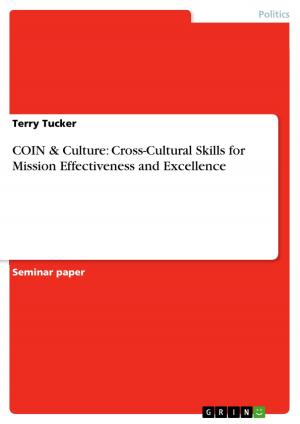How and why was the intelligentsia important fpr the West German student movement?
Nonfiction, Social & Cultural Studies, Social Science| Author: | Roman Esser | ISBN: | 9783638253635 |
| Publisher: | GRIN Publishing | Publication: | February 12, 2004 |
| Imprint: | GRIN Publishing | Language: | English |
| Author: | Roman Esser |
| ISBN: | 9783638253635 |
| Publisher: | GRIN Publishing |
| Publication: | February 12, 2004 |
| Imprint: | GRIN Publishing |
| Language: | English |
Essay from the year 2004 in the subject Sociology - Individual, Groups, Society, grade: 1.0 (A), Lancaster University (Department for European Languages and Cultures), course: Youth and Political Culture in the 1960s., 7 entries in the bibliography, language: English, abstract: The following essay is supposed to follow the question 'How and why was the intelligentsia important for the West German student movement'. It is primarily essential to clarify two significant points in order to answer this question. Firstly, in contrast to popular thought there was never such thing as one solid West German student movement. There were always different -partly opposite- student groups. The spectrum of the student movement embraced groups of various political persuasions, 'ranging from the [conservative, R.E.] Christian Democrats, to the Liberal students, the more moderate socialist students (S.H.B.) and the radical socialist federation of students (S.D.S.).'1 To simplify matters it is necessary to reduce the complexity of all these groups. The SDS (Sozialistischer Deutscher Studentenbund) was undisputedly the most important group of the student movement, having occupied the leading role in the student protests. Besides, most discussions and intellectual approaches started within the SDS or within its numerous organisations.2 Though, it offers to reduce the concept of West German student movement to the SDS for reasons of practicability. [...] 1 Weller/Will v.d., 52 2 Langguth, 36
Essay from the year 2004 in the subject Sociology - Individual, Groups, Society, grade: 1.0 (A), Lancaster University (Department for European Languages and Cultures), course: Youth and Political Culture in the 1960s., 7 entries in the bibliography, language: English, abstract: The following essay is supposed to follow the question 'How and why was the intelligentsia important for the West German student movement'. It is primarily essential to clarify two significant points in order to answer this question. Firstly, in contrast to popular thought there was never such thing as one solid West German student movement. There were always different -partly opposite- student groups. The spectrum of the student movement embraced groups of various political persuasions, 'ranging from the [conservative, R.E.] Christian Democrats, to the Liberal students, the more moderate socialist students (S.H.B.) and the radical socialist federation of students (S.D.S.).'1 To simplify matters it is necessary to reduce the complexity of all these groups. The SDS (Sozialistischer Deutscher Studentenbund) was undisputedly the most important group of the student movement, having occupied the leading role in the student protests. Besides, most discussions and intellectual approaches started within the SDS or within its numerous organisations.2 Though, it offers to reduce the concept of West German student movement to the SDS for reasons of practicability. [...] 1 Weller/Will v.d., 52 2 Langguth, 36















